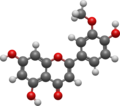Chrysoeriol
Chrysoeriol is a natural flavonoid found in various plants. It is a type of flavone, a subclass of flavonoids, characterized by its yellow color. Chrysoeriol is known for its antioxidant properties and potential health benefits, including anti-inflammatory and anticancer activities. This compound has been the subject of various scientific studies due to its presence in a wide range of medicinal plants and its potential therapeutic effects.
Chemical Structure and Properties[edit]
Chrysoeriol has the chemical formula C_16H_12O_6 and is also known by its chemical name, 5,7-Dihydroxy-2-(4-hydroxy-3-methoxyphenyl)-4H-chromen-4-one. It is structurally related to other flavonoids such as luteolin and quercetin, differing primarily in the pattern of hydroxylation and methoxylation on the flavone core. The presence of hydroxyl and methoxyl groups in its structure contributes to its antioxidant activity, enabling it to scavenge free radicals and protect cells from oxidative stress.
Sources[edit]
Chrysoeriol is found in a variety of plants, including herbs, vegetables, and teas. It is particularly abundant in the leaves of Rosmarinus officinalis (rosemary), Artemisia annua (sweet wormwood), and certain species of Mentha (mint). These plants have been used in traditional medicine for centuries, and their beneficial effects are partly attributed to the presence of chrysoeriol and other bioactive compounds.
Biological Activities[edit]
Antioxidant Activity[edit]
Chrysoeriol's antioxidant activity is one of its most notable properties. By neutralizing free radicals, it can help prevent cellular damage and reduce the risk of chronic diseases associated with oxidative stress, such as cardiovascular diseases and cancer.
Anti-inflammatory Activity[edit]
This flavonoid has also been shown to possess anti-inflammatory properties. It can inhibit the production of pro-inflammatory cytokines and enzymes, thereby reducing inflammation and potentially alleviating symptoms of inflammatory diseases.
Anticancer Activity[edit]
Preliminary research suggests that chrysoeriol may have anticancer effects by inducing apoptosis (programmed cell death) in cancer cells, inhibiting tumor growth, and preventing the spread of cancer cells. However, further studies are needed to fully understand its mechanisms of action and potential therapeutic applications in cancer treatment.
Potential Health Benefits[edit]
Due to its antioxidant, anti-inflammatory, and anticancer activities, chrysoeriol may offer various health benefits. It could potentially play a role in the prevention and treatment of certain diseases, although more research is needed to confirm these effects and establish effective dosages.
Conclusion[edit]
Chrysoeriol is a promising natural compound with a range of potential health benefits. Its presence in various medicinal plants underscores the importance of these plants in traditional and modern medicine. As research into chrysoeriol and its biological activities continues, there is potential for the development of new therapeutic agents based on this flavonoid.
Chrysoeriol[edit]
-
Chrysoeriol structure diagram
-
3D ball-and-stick model of Chrysoeriol
Ad. Transform your life with W8MD's Budget GLP-1 injections from $75


W8MD offers a medical weight loss program to lose weight in Philadelphia. Our physician-supervised medical weight loss provides:
- Weight loss injections in NYC (generic and brand names):
- Zepbound / Mounjaro, Wegovy / Ozempic, Saxenda
- Most insurances accepted or discounted self-pay rates. We will obtain insurance prior authorizations if needed.
- Generic GLP1 weight loss injections from $75 for the starting dose.
- Also offer prescription weight loss medications including Phentermine, Qsymia, Diethylpropion, Contrave etc.
NYC weight loss doctor appointmentsNYC weight loss doctor appointments
Start your NYC weight loss journey today at our NYC medical weight loss and Philadelphia medical weight loss clinics.
- Call 718-946-5500 to lose weight in NYC or for medical weight loss in Philadelphia 215-676-2334.
- Tags:NYC medical weight loss, Philadelphia lose weight Zepbound NYC, Budget GLP1 weight loss injections, Wegovy Philadelphia, Wegovy NYC, Philadelphia medical weight loss, Brookly weight loss and Wegovy NYC
|
WikiMD's Wellness Encyclopedia |
| Let Food Be Thy Medicine Medicine Thy Food - Hippocrates |
Medical Disclaimer: WikiMD is not a substitute for professional medical advice. The information on WikiMD is provided as an information resource only, may be incorrect, outdated or misleading, and is not to be used or relied on for any diagnostic or treatment purposes. Please consult your health care provider before making any healthcare decisions or for guidance about a specific medical condition. WikiMD expressly disclaims responsibility, and shall have no liability, for any damages, loss, injury, or liability whatsoever suffered as a result of your reliance on the information contained in this site. By visiting this site you agree to the foregoing terms and conditions, which may from time to time be changed or supplemented by WikiMD. If you do not agree to the foregoing terms and conditions, you should not enter or use this site. See full disclaimer.
Credits:Most images are courtesy of Wikimedia commons, and templates, categories Wikipedia, licensed under CC BY SA or similar.
Translate this page: - East Asian
中文,
日本,
한국어,
South Asian
हिन्दी,
தமிழ்,
తెలుగు,
Urdu,
ಕನ್ನಡ,
Southeast Asian
Indonesian,
Vietnamese,
Thai,
မြန်မာဘာသာ,
বাংলা
European
español,
Deutsch,
français,
Greek,
português do Brasil,
polski,
română,
русский,
Nederlands,
norsk,
svenska,
suomi,
Italian
Middle Eastern & African
عربى,
Turkish,
Persian,
Hebrew,
Afrikaans,
isiZulu,
Kiswahili,
Other
Bulgarian,
Hungarian,
Czech,
Swedish,
മലയാളം,
मराठी,
ਪੰਜਾਬੀ,
ગુજરાતી,
Portuguese,
Ukrainian


